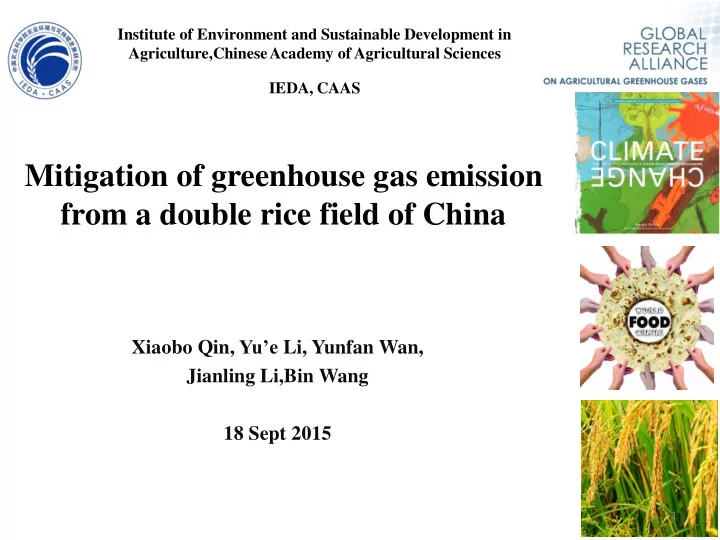

Institute of Environment and Sustainable Development in Agriculture,Chinese Academy of Agricultural Sciences IEDA, CAAS Mitigation of greenhouse gas emission from a double rice field of China Xiaobo Qin, Yu’e Li, Yunfan Wan, Jianling Li,Bin Wang 18 Sept 2015 1
In this talk In this talk Stock-take Research updates Future work 2
Stock-take Stock-take Project: Monitor and control of GHG emission reduction technologies from agricultural production system of China Period: 2011-2015 Fund: Non-profit Research Foundation for Agriculture (201103039), Ministry of Agriculture 3
Grass land North East upland Institute of Atmospheric Physics, CAS Institute of applied ecology, CAS Live stock IEDA, CAAS North China upland North West up land Shandong Academy China agricultural of agricultural university sciences Single rice Dobule rice Institute of Soil Science, CAS IEDA, CAAS Project Host: Chinese academy of agricultural sciences, CAAS 4
Double rice production of China Double rice Double rice - fallow Double rice - rape Double rice - vegetable 5
Objectives Stock-take Demonstration Localization Screen Practical mitigation technologies Monitor GHG emission 6
Mitigation choice Cultivar Bio-waste Nitrogen Biochar Inhibitor Mitigation technology 7
Field monitor B e i j i n g China J i n g z h o u C h a n g s h a H u i z h o u u 8
Application of the biochar Application of biochar kg ha -1 Base fertilization Tillering Jointing fertilization Booting fertilization Ttreatments fertilization N b N b b K 2 O b P 2 O 5 K 2 O Biochar Straw N (Urea) N (Urea) K 2 O (KCL) P 2 O 5 CK 72.00 135.00 72.00 34.50 55.20 45.00 36.00 36.00 36.00 BC1 72.00 135.00 72.00 5000 34.50 55.20 45.00 36.00 36.00 36.00 BC2 72.00 135.00 72.00 10000 34.50 55.20 45.00 36.00 36.00 36.00 BC3 72.00 135.00 72.00 20000 34.50 55.20 45.00 36.00 36.00 36.00 RS 72.00 132.36 72.00 2400 19.38 55.20 24.60 36.00 36.00 36.00 RI 72.00 132.36 72.00 2400 19.38 55.20 24.60 36.00 36.00 36.00 9
Characteristics of the rice cultivar Cultivar Growth Optimum Rice quality class Eating Cold Rice blast Lodging days grain yield National Provincial quality resistance resistance resistance (kg ha -1 ) (d ) standard standard score Hefengzhan 128-130 410.75 3 3 74 Medium 83.3-88.89% Medium Yuejingsimiao 111-114 405.37 2 2 81 Medium weak 98.55-100% - Qihuazhan 108-111 437.02 2 2 75-84 Medium 76.47-86.9% Medium strong Huangsizhan 129 437.86 1 1 90 Weak 63-63.77% Medium Huangruanzhan 132 435.54 - 3 76-81 Medium 95.5-100% Medium Yexianzhan 6 113 431.83 1 - - Strong 65% Medium Yexianzhan 8 110-117 435.69 3 - - Medium 53.5% Strong Huangxiuzhan 110-111 424.57 2 - 78-81 Medium 93.4% Medium strong Yueerzhan 127-130 461.70 2-3 - - Medium 41.9% Weak 10
Modification of new N fertilizer Jingzhou agrometeorological experimental station, Hubei province, China(30 ° 21'N, 112 ° 09'E), from May 3 rd , 2012 to April 28 th , 2014 An automatic sampling and monitoring system was used on each day during the rice growing season Manual sampling was undertaken at intervals of 10 days during the winter fallow period CH 4 and N 2 O were analyzed by a gas chromatograph (Agilent 7890A) 11
Technology screen Yield – scaled GHG emission 20� Rice yield 水 稻产量 100� Same rice cultivar Different rice cultivar 碳排放强度 80� 15� 60� 相比 CK 百分比 Ratio / % 40� 相比 CK 百分比 Ratio / % 10� 20� 0� BCH� BCM� RI� CK� QH� YX8� YE� -20� 5� -40� -60� 0� -80� BCH� BCM� RI� CK� QH� YX8� YE� -100� 100� GHG emission GHG 排放当量 80� Biochar: 20t ha -1 60� Ratio / % Cultivar: Qihuazhan, 40� 相比 CK 百分比 Yue’erzhan , Yexianzhan 8 20� 0� BCH� BCM� RI� CK� QH� YX8� YE� -20� Low GWP and High -40� yield -60� -80� 12 (Qin et al., 2014, 2015) -100�
CO2 eq(N2O) 10 2012 10 0% 2013 Treat : a 0% 9 9 CO2 eq(CH4) GWP ( Mg CO 2 eq ha -1 ) a 8 8 29.2% 29.4% 22.0% 31.5% CK Urea (N≥46% ) ① 7 7 b 29.4% b b 37.6% b b 39.5% b 6 6 bc 48.5% 5 5 c ② CRU Polymer-coated 4 4 3 3 controlled release urea 2 2 (N≥42%, release period 90d) 1 1 0 0 CK CRU NU DMPP EM CK CRU NU DMPP EM NU N- Sever (N≥46%), a ③ GWP of different treatments in 2012 (left panel) and 2013 (right panel) rotations Modified N fertilizer synthetic urea mixed with 0.8 2013 Rice season 0.8 2012 a GHGI ( Mg CO 2 eq Mg -1 grain ) 0.5% nitrapyrin Whole rotation 0.7 0.7 a Low GWP and High yield 0.6 a 0.6 a b ④ DMPP Urea with 1% 0.5 b b b 0.5 b b bc b b 0.4 b bc b 0.4 b nitrification inhibitor 3,4- bc 0.3 c 0.3 c dimethylpyrazole phosphate 0.2 0.2 0.1 0.1 ⑤ EM Urea with effective 0.0 0.0 CK CRU NU DMPP EM CK CRU NU DMPP EM microorganisms GHGI of different treatments in 2012 (left panel) and 2013 (right panel) rotations Lower GWP and higher yield were observed with controlled release urea, nitrification inhibitor and effective microorganisms use. Polymer-coated urea reduced CH 4 emission significantly. Nitrification inhibitors reduced N 2 O emission significantly. N 2 O emissions and CH 4 consumptions were notable during fallow period. (Wang et al., 2015, AEE) 13
Demonstration Demonstration area: 4000 acre Guangdong Hubei 14
Priorities of research needs Stock-take I want you ? Practicable mitigation option Future work N 2 O emission from rice paddy Uncertainty Ignore or not? 15
Thank you for your attention! 16
Recommend
More recommend